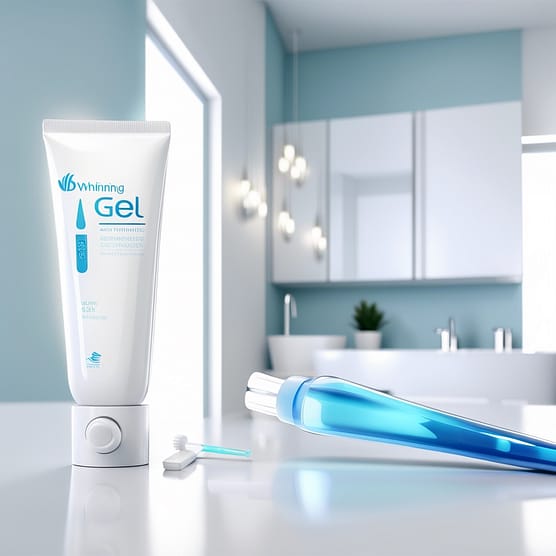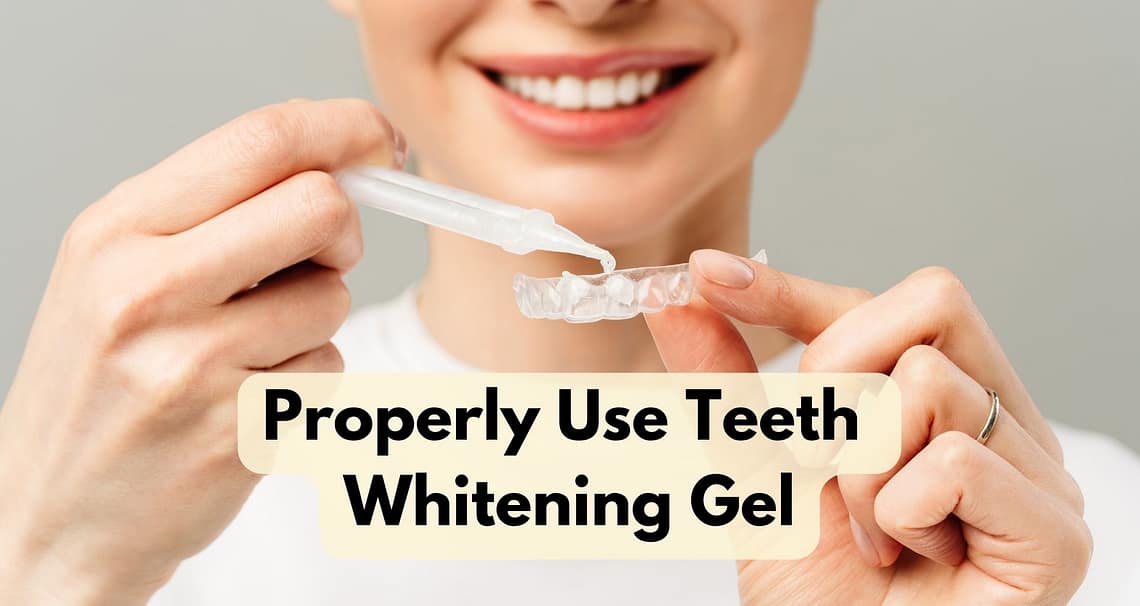Have you ever wondered how to effectively use teeth whitening gel to achieve a brighter smile? Look no further! This article will provide you with all the necessary information on properly using teeth whitening gel. From step-by-step instructions to frequently asked questions, we’ve got you covered.
By the end of this article, you’ll have a clear understanding of how to make the most out of your teeth whitening gel and achieve the dazzling smile you’ve always desired. So, let’s dive right in and discover the secrets to a brighter, more confident smile!
Choosing the Right Teeth Whitening Gel
When it comes to choosing the right teeth whitening gel, it’s important to understand the different types available in the market. Teeth whitening gels generally contain either hydrogen peroxide or carbamide peroxide as the active whitening agent. The concentration of the whitening agent is also an important factor to consider.
Understanding different types of teeth whitening gels
Teeth whitening gels come in various forms, including gel pens, trays, strips, and syringes. Gel pens are convenient for targeted application, while trays cover all the teeth and provide more even whitening. Strips offer a simple and mess-free option, while syringes allow for precise control of the gel application. Consider your preferences and lifestyle when choosing the right type of gel for you.
Determining the concentration of whitening agent
The concentration of the whitening agent in the gel determines its strength and effectiveness. Higher concentrations typically provide faster results, but they can also increase the risk of sensitivity. It’s essential to find the right balance between achieving desired results and minimizing potential side effects. Consult with your dentist to determine the appropriate concentration of whitening gel for your specific needs.
Checking for ADA approval
The American Dental Association (ADA) evaluates oral care products for safety and efficacy. Look for the ADA Seal of Acceptance on teeth whitening gels to ensure that it has undergone rigorous testing and meets the industry standards. This seal is an assurance that the product is safe and effective when used as directed.
Considering sensitivity issues
Teeth sensitivity is a common side effect of teeth whitening. If you are prone to sensitivity or have experienced it in the past, it’s important to choose a teeth whitening gel that is specifically formulated for sensitive teeth. These gels typically have lower concentrations of the whitening agent and added desensitizing ingredients to minimize discomfort.
Preparing for Teeth Whitening
Before starting any teeth whitening treatment, it’s crucial to consult with your dentist. They can evaluate your oral health and determine if teeth whitening is appropriate for you. Additionally, getting a dental check-up prior to whitening is important to address any underlying oral health issues that may interfere with the whitening process.
Consulting with your dentist
Your dentist is the best person to guide you through the teeth whitening process. They can assess your dental health, recommend suitable whitening options, and provide professional guidance on how to use teeth whitening gel effectively and safely. Consulting with your dentist ensures that you are making an informed decision and following a personalized whitening plan.
Getting a dental check-up
Before undergoing any teeth whitening treatment, it’s essential to have a dental check-up. Your dentist will evaluate your teeth and gums for any signs of decay, gum disease, or other potential problems that may affect the whitening process. Treating these issues beforehand will help ensure optimal results and prevent any complications.
Addressing any oral health issues
If your dentist identifies any oral health issues during the check-up, such as cavities or gum inflammation, it is crucial to address them before proceeding with teeth whitening. These issues should be resolved to avoid worsening or causing additional sensitivity during the whitening process. Your dentist will provide appropriate treatments or recommendations to address these concerns.
Following pre-whitening instructions
Different teeth whitening gels may have specific instructions for preparation and application. It’s important to carefully read and follow the instructions provided with the gel. Some gels may require you to brush your teeth before applying the gel, while others recommend avoiding certain foods and beverages in the hours leading up to the treatment. Following these instructions will ensure optimal results and minimize the risk of complications.
Using Teeth Whitening Gel at Home

Source: TheTechBrain AI
Using teeth whitening gel at home allows for convenience and flexibility in your whitening journey. To ensure the best results, it’s important to understand how to properly use the gel and choose the right application method.
Reading and following the instructions
Before using any teeth whitening gel, it’s essential to thoroughly read and understand the instructions provided by the manufacturer. Each gel may have specific guidelines on application time, frequency, and other important factors. Following these instructions will help you achieve the desired results safely and effectively.
Choosing the right application method
Teeth whitening gels can be applied using different methods, including trays, strips, or gel pens. Trays provide full coverage and even distribution of the gel, while strips offer a simpler application process. Gel pens are convenient for targeted application on specific teeth. Consider your preferences and needs when choosing the right application method for you.
Applying the gel evenly on the teeth
When applying the gel, it’s important to ensure even coverage on all the teeth you wish to whiten. Use a tray or strip that covers all the teeth, or apply the gel evenly using a gel pen. Uneven application may result in uneven whitening and inconsistent results. Take your time to ensure that every tooth is adequately coated with the gel.
Avoiding excessive gel application
While you may be tempted to use more gel for faster results, it’s important to follow the recommended dosage. Using excessive gel can increase the risk of sensitivity and gum irritation. Stick to the recommended amount provided by the manufacturer or your dentist to ensure safe and effective whitening.
Using custom trays or strips
Custom trays or strips, which are made specifically for your teeth, can offer a more comfortable and effective whitening experience. Custom trays provide a better fit and ensure that the gel comes into close contact with all the surfaces of your teeth. This can result in more consistent and thorough whitening.
Preventing gel contact with gums and soft tissues
To avoid irritation or sensitivity, it’s crucial to prevent the whitening gel from coming into direct contact with your gums or other soft tissues. Excess gel that touches the gums can cause temporary discomfort or even chemical burns. Follow the instructions carefully and use a gentle hand to ensure that the gel is only applied to the teeth.
Also Check: What Is A Peptide Facial And How Does It Work?
Monitoring the Whitening Process
As you progress through the teeth whitening process, it’s important to monitor and observe the changes in your teeth. This will help you track the recommended usage time, be aware of any possible side effects, and assess the progress of your whitening journey.
Keeping track of the recommended usage time
Teeth whitening gels typically have recommended usage times specified by the manufacturer. It’s important to adhere to these guidelines and not exceed the recommended duration of use. Overusing the gel may lead to increased sensitivity or other adverse effects. Use a timer or set reminders to ensure that you are staying within the recommended usage time.
Being aware of any possible side effects
While teeth whitening gels are generally safe when used as directed, it’s important to be aware of any potential side effects. These may include temporary tooth sensitivity, gum irritation, or uneven whitening. If you experience any unusual or persistent side effects, discontinue the use of the gel and consult with your dentist.
Observing the progress of teeth whitening
Regularly observe the progress of your teeth whitening journey by comparing your current shade to the shade before starting the treatment. It’s important to note that teeth whitening is a gradual process, and results may vary from person to person. Patience is key, and consistent use of the gel will eventually lead to noticeable results.
Noticing any sensitivity issues
Teeth sensitivity is a common side effect of teeth whitening. If you start experiencing sensitivity during the whitening process, it’s important to address it promptly. Take a break from whitening for a few days and resume using the gel once the sensitivity subsides. If sensitivity persists or becomes severe, consult with your dentist for further guidance.

This image is property of images.pexels.com.
Maintaining Oral Hygiene During the Whitening Process
While undergoing teeth whitening, it’s crucial to maintain good oral hygiene practices to maximize the results and keep your teeth and gums healthy.
Maintaining regular brushing and flossing
Brushing your teeth at least twice a day and flossing daily are essential habits for maintaining oral hygiene. These practices help remove plaque and prevent staining, which can interfere with the whitening process. Use a soft-bristled toothbrush and a fluoridated toothpaste to gently and effectively clean your teeth.
Using a non-whitening toothpaste
During the teeth whitening process, it’s recommended to use a non-whitening toothpaste. Whitening toothpaste can contain abrasive particles that may interfere with the whitening gel’s effectiveness. Choose a toothpaste that is specifically formulated for sensitive teeth, if applicable, to minimize the risk of sensitivity.
Avoiding foods and drinks that stain teeth
Certain foods and drinks can stain your teeth and diminish the results of teeth whitening. Avoid or limit the consumption of coffee, tea, red wine, berries, and other staining substances. If you do indulge in these foods or drinks, rinse your mouth with water afterward or brush your teeth gently to minimize staining.
Quitting smoking and tobacco products
Smoking and tobacco products are major culprits when it comes to teeth staining. The chemicals in tobacco can cause yellowing and discoloration of the teeth, which can be challenging to whiten. Quitting smoking or using tobacco products will not only improve the results of teeth whitening but also benefit your overall oral health.
Considering dietary changes
Certain dietary changes can help maintain the whiteness of your teeth. Incorporate more fruits and vegetables into your diet, as they can help remove surface stains and promote healthy teeth and gums. Crunchy foods like apples and carrots can also act as natural teeth cleaners by gently scrubbing away plaque.
Dealing with Teeth Sensitivity
Teeth sensitivity is a common concern when using teeth whitening gels. If you experience sensitivity during the whitening process, there are several measures you can take to alleviate discomfort.
Understanding the causes of sensitivity
Teeth sensitivity can be caused by the penetration of the whitening agents through the enamel and into the dentin, which contains nerve endings. Overusing teeth whitening gel, using a high-concentration gel, or having naturally sensitive teeth can contribute to sensitivity. Understanding these causes can help you make informed decisions and take appropriate measures.
Using desensitizing toothpaste or gel
Desensitizing toothpaste or gel can provide relief for sensitive teeth. These products work by blocking the nerve endings and reducing sensitivity. Consider using a toothpaste or gel specifically designed for sensitive teeth for a period leading up to and during the teeth whitening process. This can help minimize any discomfort associated with sensitivity.
Reducing whitening frequency or duration
If you experience sensitivity, it may be necessary to reduce the frequency or duration of the whitening treatments. Take breaks between whitening sessions or shorten the duration of each session. Gradually increase the frequency and duration as your teeth become more tolerant. Listen to your body and adjust the whitening routine accordingly.
Opting for lower concentration gels
Lower-concentration gels are generally less likely to cause sensitivity compared to higher concentrations. If you have experienced sensitivity in the past or are concerned about it, consider using a gel with a lower concentration of the whitening agent. Your dentist can guide you in choosing the right concentration that balances effectiveness and sensitivity.
Applying fluoride treatments
Fluoride treatments can help strengthen and protect your teeth, reducing the risk of sensitivity. Consider using a fluoride mouthwash or gel as part of your oral care routine, especially during the whitening process. This can provide an added layer of protection and help maintain the health of your teeth.
FAQs (Frequently Ask Question)
Q: How long does it take for teeth whitening gel to work?
The time it takes for teeth whitening gel to work varies depending on factors such as the concentration of the gel, the frequency of use, and individual characteristics. Generally, gradual improvement can be noticed within a few days to a couple of weeks. Significant results may take several weeks to achieve.
Q: Are teeth whitening gels safe?
Teeth whitening gels, when used as directed, are generally safe. However, it’s important to follow the instructions provided by the manufacturer or your dentist. Overuse of the gel or using a higher concentration than recommended can increase the risk of sensitivity and other side effects. Consult with your dentist to ensure safe and effective use of teeth whitening gel.
Q: Can I use teeth whitening gel if I have dental restorations?
Teeth whitening gel is generally not effective on dental restorations such as crowns, veneers, or fillings. The whitening agent in the gel only works on natural tooth enamel. If you have dental restorations, discuss with your dentist to determine the best course of action for achieving a uniform smile.
Q: How often should I use teeth whitening gel?
The frequency of teeth whitening gel usage depends on the specific product and its recommended guidelines. Some gels are designed for daily use, while others may recommend a few times a week. It’s important to follow the instructions provided with the gel and consult with your dentist for personalized recommendations.
Q: Are there any side effects of teeth whitening gel?
Teeth whitening gels can have side effects, although they are generally mild and temporary. These may include tooth sensitivity, gum irritation, and temporary discoloration of the gums or lips. These side effects usually subside once you complete the whitening treatment. If you experience persistent or severe side effects, consult with your dentist.
Conclusion
Choosing the right teeth whitening gel and properly using it can help you achieve a brighter and more confident smile. Before beginning any teeth whitening treatment, it’s important to understand the different types of gels available, determine the concentration of the whitening agent, and ensure ADA approval. Consulting with a dentist, getting a dental check-up, and addressing any oral health issues are essential steps to prepare for teeth whitening.





